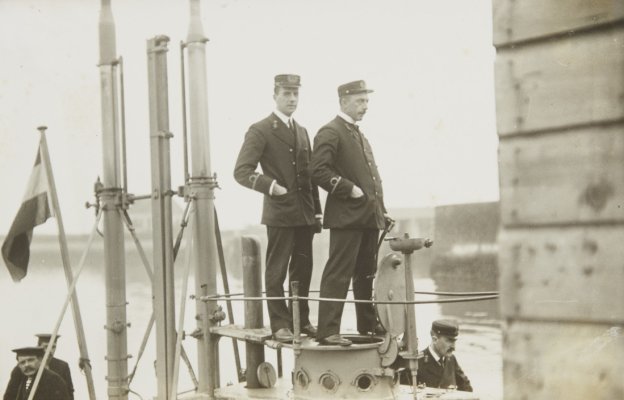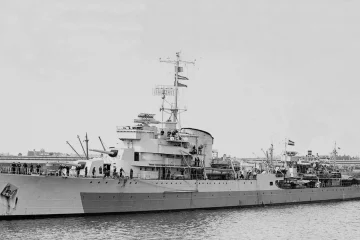Parliamentary inquiry into government policy 1940-1945
This parliamentary inquiry focused on the government policy of the cabinets De Geer, Gerbrandy and Schermerhorn, since the German invasion of the Netherlands on 10 May 1940 and in relation to Netherlands East indies (NEI) the war with Japan until the opening of the session of the provisional States-General on 20 November 1945, as well as on preliminary policy for insofar as it was directly related to the events of the aforementioned periods.
The survey was conducted between 1947 and 1956 on the basis of a proposal by the PvdA group chairman Van der Goes van Naters (PvdA). The chairman of the committee of inquiry was successively the PvdA members Dark (1947-1952) and Schilthuis (1952-1956) and the KVP member Quotesi (KVP). The committee had nine members. Among them were Dame Wttewaall van Stoetwegen, and the later ministers Algerai and Korthals.
The committee produced eight sub-reports (a total of 19 volumes) in which its reports and conclusions can be found. Specifically, this included military policy, financial and economic policy, preparations for the restoration of democracy after liberation, the ministerial and cabinet crises, aid to the Dutch, secret services, foreign relations, the Neutrality policy until 1940 and connections with occupied territory. A total of 850 witnesses were called.
In relation to the war with Japan also the Australia-based Deputy Commander Netherlands Armed Forces East was called up as a witness in 1949. He was interviewed by Algerai and Korthals . The following is a summary of his answers to the Inquiry.
The full interview (in Dutch) can be found here.
Coster appointed to establish a Purchasing Commission in Australia

On 1 January 1942 Frederik Hendrik Coster was recalled from retirement – he had been retired since October 1935. He was reinstated on active duty as Rear Admiral titular and was appointed chairman of the Purchasing Commission in Melbourne, Australia.
As he mentioned, in Australia there was then a fairly decent market for all kinds of things, which were no longer available after the fall of the Netherlands. That’s where quite a lot came from for the NEI force.
Reorganisation of Dutch troops in Australia
Shortly afterwards, in March 1942, he received a telegram from the commander of the Dutch naval forces in London, requesting that he be entrusted with receiving and reorganising the naval personnel arriving in Australia from Java. This telegram effectively put him in a military context. Until this moment he held an NEI Government function, not a purely military function. Later his position was expanded and he was also involved in the reorganisation of the NEI Army (and the Air Force).
This was a significant position and in the interview he estimated that it involved between 2000 and 5000 troops, aircraft and ships.
Major General van Oyen of the Royal Netherlands East Indies Army (KNIL), who was older in rank than Coster, previously held general military command in Australia, under the title of Deputy Commander Armed Forces East. By order of the Netherlands Government in London, he soon left Australia for America and Coster assumed also his position as Deputy Commander Armed Forces East plus his de facto position Commander Dutch Navy Australia. He reported to Admiral Conrad Helfrich Commander in chief of Dutch Forces in the East, based in Ceylon.
The reorganisation was extremely difficult. Although Coster was commander of the Navy in Australia, he was practically on his own. There was nothing. There was no place to house the people, there was no organisation, which provided food, and no organisation, which provided clothes. Everything had to be improvised. He however, had a lot of help from the Australian Navy. With that help, he took care of people, who arrived practically naked, just with a shirt and shorts with which the people had on in NEI when they went on board. For Australia, where it is cooler than in NEI, this was not enough. These people also had to be taught military spirit again. Because of everything they had experienced, people’s morale was not exactly high at first.
Most of the men and equipment arrived at Fremantle, a smaller proportion in Adelaide and the rest in Melbourne. The distance from Perth to Melbourne is 3500 km so, a train takes five days over that distance, it was therefore not easy to get all this done.
Melbourne was the main station for the Navy. Immediately from London came the request to send as many able-bodied people as possible to England to take part in the European warfare at sea. Most of them went by ship from Melbourne to England. The ships, which were left in Australia, were manned and with that the war here was carried out. These ships operated mainly from Perth, later also from Darwin.
Deputy Commander Armed Forces East – Navy
Coster received a telegram from the commander of naval forces in London to transfer what was left of the Dutch Navy to the operational command of General MacArthur. The Australian Navy was also operating under U.S. command.
General MacArthur had the command which, as far as the Navy was concerned, he had transferred to his fleet governor, Admiral Leahy at the time. (ed. most likely he meant here: Admiral Chester W. Nimitz, the commander in chief of the Pacific Ocean Areas, William Daniel Leahy was the Chief of Staff to the Commander in Chief based in Washington). Under MacArthur, Nimitz was in charge of operations at sea. Coster had to deal mainly with General MacArthur and also with Leahy (Nimitz) and with Admiral Sir Guy Royle, the Chief of the Naval Staff of the Royal Australian Navy (RAN). He was responsible for the overall strategic direction of the RAN during the war.
Other Dutch liaison officers at MacArthur’s headquarters were Captain Koppers, Captain Spoor, Sandberg and temporarily Also Captain de Vries. It was an army representation, because General MacArthur was a general and the Dutch in Australia had no naval officers overcomplete.
The Dutch Navy was attached to the American Seventh Fleet. In addition to Coster, there were also other Dutch liaison officers in the U.S. Navy. Like Lieutenant Quéré, who was actually in the Intelligence Service. He had started setting up NEFIS in Australia. Later, the then captain-lieutenant-at-sea Saint became its chief. Salm was succeeded as chief of the Nefis by Captain Spoor. Lieutenant Quéré was charged with bringing parties into NEI. So he had to try to smuggle agents to NEI with submarines ashore; These agents had to try to get messages. This never yielded much result. Many of these parties never came back.
Later, parties were sent to New Guinea, which did have some success. It has not been successful in Java. From Colombo they worked on, Sumatra, but Coster had less data. They did manage to keep officers ashore for 24 hours.
The separation that took place between the naval forces in Ceylon and Australia was originally quite arbitrary, until this was settled afterwards. Initially, they were in a defensive position in both places. When Coster arrived in Australia, there was great fear of a Japanese invasion, which could be expected every day. The position in Ceylon was also defensive. Later, Australia was called into offensive action, which was led by the Americans, and more forces were sent from Ceylon and England to Australia to participate. Admiral Helfrich suggested moving the naval headquarters from Ceylon to Australia, but London did not agree.
According to Coster, Helfrich’s original intention had been to evacuate everything to Ceylon. However, this order was either not properly executed or did not come through properly. A significant amount of the equipment has ended up in Australia. Later it was studied where the different components could best be used. A significant part of the naval service in Australia then went to Ceylon. The commander of naval forces in London brought some of the necessary personnel to London.
According to Coster, it would have been better to bring as many forces as possible to Australia, because almost the entire area of NEI fell under the American territory. Only Sumatra was under the British Command, here General Mountbatten was in command. So it was the issue where Dutch aid could best be used.
Deputy Commander Armed Forces East – Army
According to Coster, there was practically nothing left of the Army. As far as he could remember there was a company of military police, who had fled from New Guinea to Australia with small ships and had arrived there, their commander was not too good, Coster later had to court-martial him.
Later, the army was slightly reinforced with troops who had held out in Timor, but there were not many.
A force has always remained on New Guinea, but only on the southeastern part of Merauke. There were no more troops on the Vogelkop, after the Edwards company had fled from Muyen to Australia. Later these troops (between 100 and 200 soldiers) went to Merauke. Dutch conscripts in Australia were also sent to Merauke with the aim of setting up a battalion there.
Deputy Commander Armed Forces East –Air Force
All pilots in training had been transported from Java to Australia before the fall. The flying school was therefore already housed in Australia when Java fell, because Bandung could no longer be used for the training. In January 1942 the entire training was transferred to Adelaide by aircraft and all. So there was a core of the flying force, a flying force of navy and army together. The school was later moved to Jackson, Mississippi.
NEI planes arriving in Australia (Archerfield) later became part of the 18 Squadron (NEI) RAAF. Their training took place in Canberra and later they were stationed near Darwin.
Many of the aircrafts of the Navy were destroyed during the bombing of Broome.
Coster’s later positions in Australia.
Coster’s command in Australia lasted until 1 May 1943 when he was replaced by his successor Rear Admiral Koenraad. There was a top-heavy situation both with the Dutch Government-in-Exile in London and in Australia, there were significant more officers than soldiers and while Coster would have preferred to stay on, there were not enough ships and not enough sailors to command.
Based in Melbourne he became involved with the Red Cross in this city.
In September 1945, however, he was called back into military service. At the beginning of October 1945 he led the investigation into the behaviour of naval personnel from Batavia. It was an investigation into the personal behavior of every man in wartime who had fallen into enemy hands (some 5,000 people). It had to be ascertained whether the man had done everything to stay out of enemy hands and what his behaviour had been like in captivity.
After completing this research in October 1946, he returned to Australia. On 1 January 1947 he was retired for the third time but this time permanantly.


